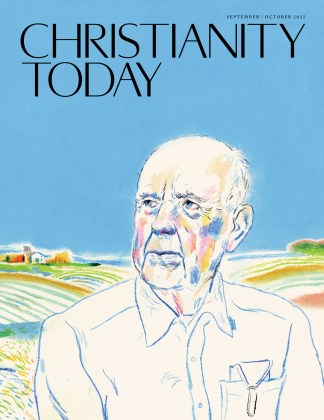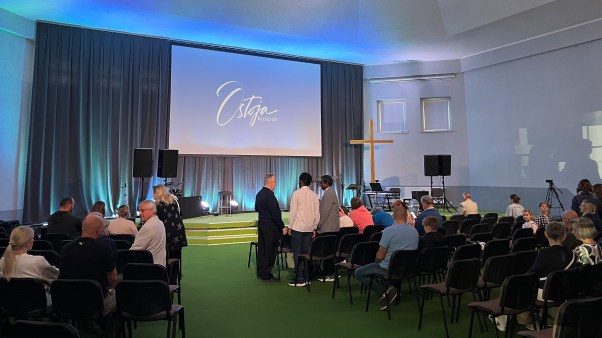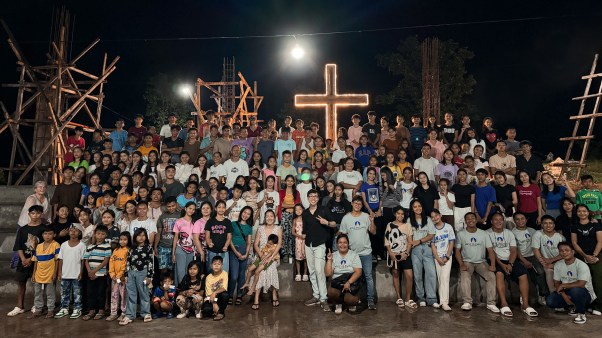When Pastor Joe Wittwer visited Iglesia Elim in Armenia, El Salvador, he saw the massive needs and wanted to help. He had already formed a close bond with Elim's husband and wife pastoral team, Frank and Paty Ardon. Despite gang warfare in the neighborhood, they were partnering with Compassion International to provide weekly care for more than 300 children and their families.
The burgeoning six-day a week ministry had forced them to add a separate building on the church grounds. But the mortgage wasn't cheap. At $500 a month (on a total mortgage of $18,000), the church was struggling to make ends meet.
A group of women helped offset the costs by making tamales and selling them in town for 25 cents apiece, but that only netted about $140 a month. Joe Wittwer's church, Life Center in Spokane, Washington, wanted to help their new friends in El Salvador, but they weren't sure how.
In the past, the pattern would have been for Wittwer and his church to swoop in and start paying the monthly mortgage, or just write a check for $18,000 to get rid of the mortgage altogether.
But that kind of "help" often ended up having negative unintended consequences. The North American churches, loaded with money, were cast as the saviors or experts sent to rescue the helpless "junior" partners. While this approach might solve a short-term problem, it rarely produced long-term solutions or fostered healthy relationships.
Now, a "Church to Church" (C2C) initiative, developed by Compassion International and the Willow Creek Association (WCA), is attempting to help churches avoid these past pitfalls by promoting genuine cross-cultural church partnerships.
C2C is simple: Compassion International matches a WCA church from North America with a church that's running a Compassion program in a village in India, Ethiopia, El Salvador, Peru, Bolivia, Uganda, Kenya, Haiti, or the Philippines.
Compassion International provides training that helps the churches avoid one-sided, dependent relationships that are based on giving money and fixing problems rather than building friendships and finding ways for ministry to flow in both directions.
Such partnerships aren't easy. Differences in language, expectations, communication, and distances (which sometimes span 11 time zones) can create profound misunderstandings. Despite these barriers, C2C has initiated 65 of these globally, and another 40 church partnerships are planned by the end of 2011.
As friendships have blossomed, the churches in India, El Salvador and Ethiopia are helping their American partners learn (and unlearn) what they know about the gospel, discipleship, community, and the mission of the church.
I talked with six participating pastors about what they've learned.
Spiritual vitality around the globe
First, the American pastors are seeing first-hand the spiritual vitality of churches across the globe. The older, traditional model of global church partnerships assumed that churches in the "developing world" were spiritually weak and missionally ineffective. But the American C2C partners I interviewed consistently praised the spiritual vitality of their global partners. For instance, consider these two international churches:
Church A consists of one church meeting in 16 locations. They have a well-defined mission: "To glorify God by making disciples." With a clear, three-step process for making disciples, they've mastered the "simple church" concept.
Church B launched a creative, organic farming business that supports their outreach to children and families. The word around town is that if you're ever in trouble, you can run to Church B and you'll find love and safety.
Name a buzzword for contemporary American churches: relevant, missional, multi-site, purpose-driven, justice-seeking, simple church—these congregations are already embodying these ideals. They just aren't American. Church A is in northern India, and Church B is in Fiche, Ethiopia, 115 km north of Addis Ababa. Both churches have one thing in common: they are courageously and strategically reaching their own communities.
"They are doing phenomenal things with limited resources," Wittwer said. "We've been humbled and convicted by their vision to reach their community. Before we arrived in Armenia, El Salvador, they already had six thriving ministries. They didn't need our advice or money to find their God-given vision."
Pastor Ed Rowell concurs. "They are the experts—they know way more than we do—about reaching their community with limited resources and in tough circumstances. In many ways, they are blazing a trail for the future of the American church. They're already grappling with the same questions that we'll have to address in the near future: How do you reach the community when you're not at the center of your culture? How do you live as salt and light when you don't have massive numbers or clout? If we're not asking those questions already, we will be asking them soon."
At one church in northern India, most of the men in the village serve as day laborers at one of the 200-plus stone quarries. It's a brutal job that produces severe health issues such as asthma, chronic injuries, and lung disease. Due to the economic downturn, it's now even harder to find work. These issues put enormous stress on local families. The village is rife with poverty, alcoholism, abuse, and family breakup.
But it gets even worse: the church is located 10 km from a major Hindu religious site, and the religious authorities would like to shut down any Christian activities on their home turf. Thus believers in the village live under the looming threat of persecution.
Despite these profound challenges, this church sustains a remarkable connection to Jesus that flows into a fearless ministry to their community, especially among the poor and oppressed. They bathe everything they do in prayer and fasting. The combined efforts of their 16 church sites (think of campuses without the video technology) have brought 350 new believers into God's kingdom, most of them first-generation Christians from Hindu backgrounds.
James Waritan and Bob Westfall report that because of the church's care for children, when the Hindu authorities threaten the church's ministries, even the local Hindu families tell the authorities to back off.
Genuine friendship
Appreciating and learning from the spiritual vitality of global churches has made genuine friendships possible. These aren't the lopsided, we're-here-to-rescue-you relationships of yesteryear.
All of the American churches we interviewed agreed: one-way relationships, based on superiority and dependency, don't work long-term. But it isn't easy to shed the traditional, dysfunctional model.
Ed Rowell defined the challenge this way: "How do you form a partnership when the financial playing field isn't level? Obviously, we have more economic resources, but we didn't want merely to play the role of gift-giver."
Brian Berg noted: "We didn't put parameters on how this relationship would go, but we did desire a new model of partnership. We wanted to help release people from poverty without creating dependency."
Previously American churches tended to go for the quick-fix. That usually implies that the resource-rich American church steps into the situation, quickly defines the problem, determines the solution, writes a check, and then flies back home.
That approach did fix some problems (and alleviated Western guilt), but it also stymied relationships and failed to provide long-term solutions.
In contrast, C2C partnerships begin with a different premise: start with a friendship. That means not attempting to accelerate or control the relationship by spending money. It's an approach that also allows American churches to slow down and learn from their global partners how to put the relationship first. In the C2C model, "being friends with you" always precedes "doing things for you."
For instance, Brian McFadden said that cultural barriers loomed large in his first meeting with Pastor Carlos and his wife. They didn't know where to start. But then Brian learned that Carlos had a business background before entering ministry, as did Brian. Soon the Texan and the Salvadoran discovered they had plenty of things to discuss.
"That's how every friendship forms," said Brian. "You get to know each other; you start talking; you listen to the other person; you explore what they like and dislike, their dreams and fears. I quickly discovered that the barriers between us were smaller and thinner than I ever imagined."
For Bob Westfall, the highlight was his friendship with the senior pastor of their partner church in India. "My favorite time involved sitting with him, sharing our lives over a cup of tea. It was a conversation between two friends, two senior pastors. If our church had swooped in with a more traditional missions model—we're here to help and rescue you—I would have completely missed the depths of this man's heart."
When he visited Ethiopia, Ed Rowell also experienced the beauty of genuine friendships. He was especially touched by the elaborate coffee-drinking ceremony with Kebede Gudeta, the pastor of the Mehal Ketema Kale Heywet Church in Debre Zeit, Ethiopia.
After slowly roasting the beans over an open fire, they transferred the coffee to a ceremonial pot and then leisurely drank it together. But this elaborate ceremony, brimming with tradition and rituals, is about more than coffee; it's about sharing life. Pastor Kebede wanted to talk about family, church, God, and ministry. This Ethiopian coffee ceremony ushered them into a sacred space of Christian community that's often hard to find in frenetic American contexts.
Back in the United States, Rowell was able to articulate what he called our "distinctively American view of poverty" that equates poverty with a lack of resources. But according to Rowell, that's not how his Ethiopian friends view poverty.
"For them, poverty is primarily about a lack of relationships," Rowell said. "If they have a little bit of food and a lot of love, they will always have enough to share. But if you don't have loving community and deep friendships, you are poor indeed."
"As busy, disconnected Americans, we tend to be resource-rich but relationship-poor," Rowell continued. "They're teaching us a simple but profound lesson: we desperately need community to grow in Christ. As a matter of fact, I now think that community may be the biggest missing ingredient in the American church. I wish I could get everyone in my church to visit our partner church just to learn how they live in community."
Working together
Of course this doesn't mean that the partner churches don't engage in mutual projects. However, there's a major difference between the C2C partnerships and previous partnerships: the C2C projects flow from the friendship, not from one side's need to provide expertise and efficiency. Once the bond of love and respect has been formed, creativity is unleashed to accomplish shared goals.
For example, based on the C2C model, Wittwer knew his church couldn't just pay off the mortgage of the Salvadoran church. "Once you enter the friendship as the 'problem-solver,' you completely change the relational dynamics," Wittwer said. "It's no longer a partnership between equals. We will no longer learn from each her. That's when helping others ends up hurting."
So what will they do instead?
"Honestly, we're not sure yet," Wittwer said. "We're still listening to them. We want to work on this together. One idea we're exploring: we might buy a couple of used vehicles so they can take their tamales to wealthier villages. That way the hardworking women could keep their jobs and make up to $1 per tamale rather than 25 cents. You see, there's a world of difference between telling them 'This is what you need' and asking them 'How can we work on this together?'"
Of course sometimes these projects work the other way: the global church assists their American church partner. Toward the end of a recent visit to his partner church in India, Brian Berg's team attended one of their Sunday morning worship services. In typical Indian fashion, everyone walked up front to bring their weekly offering. After the service, they gave the money to Berg so he could bring it back to his church in Wisconsin. Berg was stunned.
"Once you've seen the depths of their poverty," he said, "it just about kills you to accept a beautiful gift like that." But the pastor of the Indian church pulled him aside and said, "This is important. You need to receive this gift. We can help you do your mission just like you help us do ours."
Berg finally decided to accept the gift.
"He was absolutely right. If we're really partners, we had to allow them to help us."
Berg's congregation took the love offering and used it to help launch a Hispanic church in Wisconsin.
Doing and telling
One powerful theme runs through all of these church-to-church friendships: the global partners are stirring the American churches to take a holistic approach to ministry. Planted in the midst of crushing poverty, the churches in Ethiopia, India, and El Salvador are passionately sharing the good news and demonstrating the good works of Jesus.
"In the U.S. we often debate how to blend and prioritize evangelism and social action," Paul Knight said. "We talk like they're two separate items on our ministry to-do lists. Our friends in Ethiopia don't look at it that way. They have an incredible feeding program and they share the gospel at every chance they get. They don't draw fine lines between proclaiming the gospel and caring for the poor. For them it's one thing: following Jesus."
Pastor Carlos's church in San Salvador, El Salvador, also displays a holistic ministry. According to McFadden, "Every Sunday they engage the community by sharing the gospel from house-to-house. But then during the rainy season, they also go house-to-house offering to build barricades and protect homes from mudslides. It's never a choice between doing evangelism or acts of service. They just do both—instinctively, naturally, and passionately."
Wittwer witnessed the same powerful blend of evangelism and service in El Salvador when he went with Pastor Frank to visit a local family that was involved in Compassion International's children's ministry. Wittwer said: "It was a tiny, mud-floored shack without electricity or sanitation.
Throughout Pastor Frank's conversation, a local translator kept interrupting them so he could tell me what was being said, but then Frank started speaking rapidly and the translator suddenly stopped. After a few minutes our translator pulled us aside and whispered, 'Pastor Frank is evangelizing now. I will not interrupt or slow him down. This is too important. Please, let us be quiet and pray now.'"
Because the global partner churches provide practical help to the poorest of the poor—food, clothing, shelter, tutoring, medical exams—the community keeps asking, "Why are you doing this? Why do you care so much for all the children of this community?" At that point the church has an open door to express the reason for their hope and love: Jesus Christ.
As an example, the people of Fiche, Ethiopia, have a saying: "Scream and run to the church." In other words, if you ever feel threatened, unloved, or desperate, find refuge in the church.
Paul Knight tells about the first time he heard this phrase.
While visiting Fiche, Ethiopia, he went to the home of the little girl whom he had been sponsoring through Compassion International. He wanted to bring some gifts to the girl and her mother, a single mom who supported herself by operating a bar in her one-room house. During Paul's visit, the bar started to fill with rowdy men from the community. Paul's guide and translator took him by the arm and said, "We have to go now."
Paul looked back at his sponsor child, a vulnerable ten-year-old girl, and asked for more time. The crowd was getting louder, and his guide firmly said, "It's not safe for you. You must leave now." Paul started to move, but then he pointed to his sponsor child and said, "But what about my little girl?"
"Well, this is her home," the guide said.
Reluctantly moving to the street, Paul asked, "But will she be safe?"
"It's not really safe, but this is her home," the guide said.
Paul was indignant, "What does that mean," he asked, "that 'it's not really safe'?"
"Most likely everything you think it means," the guide said.
Paul fought back tears. "What can she do?"
Gently grabbing his arm, the guide said, "We teach the girls to do this: scream and run to the church. When you get to the church, you will find love and safety. The church will shelter you."
"That story broke my heart," Paul recalled.
The experience affected his ministry profoundly. He can't pastor and do church the same way anymore. He can't follow Jesus or love others the same way anymore.
The encounter with a little girl and a little church in Fiche, Ethiopia, "wrecked" Paul's life, he says, in a beautiful way, for the better. It's starting to "wreck" his church too.
That's the common theme in all the stories we uncovered in the C2C relationships. By focusing on the relationship, by forging a deep friendship across all kinds of barriers, the American churches are getting wrecked, but for the better. They are unlearning dysfunctional models for global missions—models that created one-way, dependent relationships.
They are having their eyes opened to the hardships their brothers and sisters overseas endure. And they are unlearning an arrogant, quick-fix approach, which focused on tasks and projects more than people. They're also allowing their global partners to mentor them in how to follow Jesus and impact a community for his sake.
Matt Woodley is managing editor of PreachingToday.com.
Copyright © 2011 by the author or Christianity Today/Leadership Journal.Click here for reprint information on Leadership Journal.










